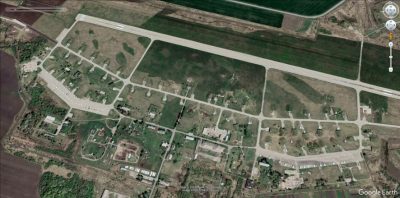What Did Russia Destroy at Starokonstantinov Airbase? “High Priority Targets”. SAM Systems Destroyed.

All Global Research articles can be read in 51 languages by activating the Translate Website button below the author’s name (only available in desktop version).
To receive Global Research’s Daily Newsletter (selected articles), click here.
Click the share button above to email/forward this article to your friends and colleagues. Follow us on Instagram and Twitter and subscribe to our Telegram Channel. Feel free to repost and share widely Global Research articles.
***
On December 14, Avia.pro reported that the Russian Aerospace Forces (VKS) sent four MiG-31K/I (interceptors modified into strike fighters) armed with 9-A-7660 “Kinzhal” air-launched hypersonic missiles (usually given the unconfirmed Kh-47M2 designation) to destroy high-priority targets at the Starokonstantinov airbase in the Khmelnitsky oblast (region). Citing Ukrainian sources, Avia.pro posits that the launch was carried out from Russia’s Lipetsk oblast, nearly 1000 km away. The attack was initially thought to have destroyed only the Soviet-era Su-24M tactical bombers modified to carry the Franco-British “Storm Shadow/SCALP EG” air-launched cruise missiles. Soon, the information was updated to include the destruction of MiG-29 and Su-27 fighter jets.
However, since then, there have been a number of reports that the actual targets were much more than the rapidly dwindling supply of older Soviet-era air superiority jets. These reports indicate not only the suspected destruction of several NATO-supplied air defense systems, including the much-touted “Patriot” SAM (surface-to-air missile) systems, but also the much more overhyped US-made F-16 fighter jets. Several milblog Telegram channels even gave the exact timing of the attacks. Citing sources “close to the leadership of the Kiev regime forces”, the reports claim that, at 16:45, three high-speed air targets were flying towards Starokonstantinov, resulting in a massive explosion two minutes later. By 16:50, at least two more explosions were recorded.
Both Russian and Ukrainian milbloggers reported that the Starokonstantinov strike is associated with solid information about the appearance of “something very important at the airbase”, which prompted the VKS to use its most dangerous air-launched missile that is generally reserved for such high-priority targets.
Prominent channels such as the “Two Majors” and the “Militarist” reported that these airstrikes were part of the wider effort that also destroyed one German-supplied “Patriot” SAM. Kiev-based Defense Express published similar reports on December 14, claiming that the VKS used the “Kinzhals” for the “first time in more than four months”, with the “last recorded strike being on August 11”, when targets in western Ukraine were hit.
Colonel Yurii Ihnat, one of the Neo-Nazi junta’s spokespeople, said that he would not comment on the information about the consequences of the attack, insisting that “[we should] let the enemy draw their own conclusions” and “[we will] not feed them information about what they targeted and what they hit”. However, even the heavily biased Kiev regime sources admitted that the attack was highly complex, involving lots of decoys and drones. Air raid sirens announced that MiG-31K/I jets took off at 11:07, which later turned out to be a false alarm. The same happened at 12:42 and 14:09, both of which were later confirmed to be false alarms, as there were no missile strikes. The next time, the aforementioned air raid sirens announced the attack only after the first explosion.
This is a clear indicator of the elaborate nature of the missile strike, once again confirming the notion that whatever was stationed at the Starokonstantinov airbase was indeed a high-priority target. The sheer magnitude of confusion in the Neo-Nazi junta sources resulted in announcements that the number of “Kinzhals” reached 15, up from just two missiles mere minutes earlier. As for the Russian military, it seems what caught the attention of its ISR (intelligence, surveillance, reconnaissance) was the urgent deployment of NATO-sourced SAM systems that were there to protect the high-priority assets. Apparently, as previously mentioned, this includes the stationing of the first highly anticipated US-made F-16 fighter jets in Ukraine.
It should be noted that, on December 24, the Russian MoD (Ministry of Defense) acknowledged successful strikes on multiple military facilities across Ukraine. This includes the destruction of SAM systems such as the NASAMS (Norwegian Advanced Surface-to-Air Missile System) and the French-made “Crotale-NG”, both at the Starokonstantinov airbase. Presumably, these air defense systems were there to protect the aforementioned high-priority assets. Interestingly, just two days prior, on December 22, the Netherlands announced that it would “soon deliver” at least 18 F-16 fighter jets. Caretaker Prime Minister Mark Rutte himself confirmed this, calling it “one of the most important elements of the agreements made on military support for Ukraine”.
Kiev regime’s Defense Minister Rustam Umerov recently stated that the F-16 is highly complex and sensitive, requiring the best possible facilities and infrastructure. The only airbase in Ukraine with such parameters is precisely the one at Starokonstantinov. Built by the USSR, it’s well-known for its sturdiness, being one of the most important Soviet airbases during the (First) Cold War. Coupled with the political West’s practice of announcing the delivery of weapons after they’ve already been transferred to the Neo-Nazi junta, as well as the fact that it had additional SAM coverage, this further reinforces the idea that the overhyped F-16 fighter jets are (or in this case, were) already at the Starokonstantinov airbase.
*
Note to readers: Please click the share button above. Follow us on Instagram and Twitter and subscribe to our Telegram Channel. Feel free to repost and share widely Global Research articles.
This article was originally published on InfoBrics.
Drago Bosnic is an independent geopolitical and military analyst. He is a regular contributor to Global Research.
Featured image is from InfoBrics

